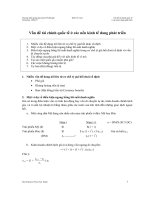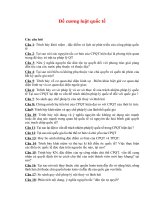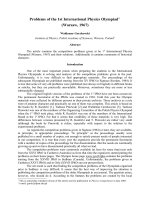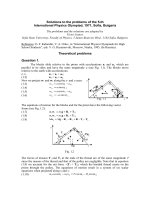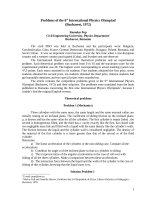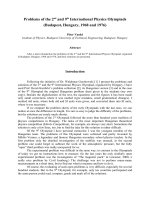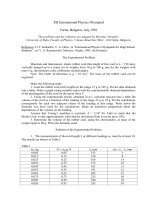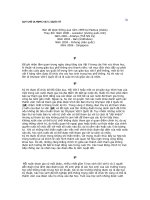Đề IPHO(vật lí quốc tế) 1976
Bạn đang xem bản rút gọn của tài liệu. Xem và tải ngay bản đầy đủ của tài liệu tại đây (157.8 KB, 10 trang )
Problems of the 2
nd
and 9
th
International Physics Olympiads
(Budapest, Hungary, 1968 and 1976)
Péter Vankó
Institute of Physics, Budapest University of Technical Engineering, Budapest, Hungary
Abstract
After a short introduction the problems of the 2
nd
and the 9
th
International Physics Olympiad, organized
in Budapest, Hungary, 1968 and 1976, and their solutions are presented.
Introduction
Following the initiative of Dr. Waldemar Gorzkowski [1] I present the problems and
solutions of the 2
nd
and the 9
th
International Physics Olympiad, organized by Hungary. I have
used Prof. Rezső Kunfalvi’s problem collection [2], its Hungarian version [3] and in the case of
the 9
th
Olympiad the original Hungarian problem sheet given to the students (my own copy).
Besides the digitalization of the text, the equations and the figures it has been made only small
corrections where it was needed (type mistakes, small grammatical changes). I omitted old
units, where both old and SI units were given, and converted them into SI units, where it was
necessary.
If we compare the problem sheets of the early Olympiads with the last ones, we can
realize at once the difference in length. It is not so easy to judge the difficulty of the problems,
but the solutions are surely much shorter.
The problems of the 2
nd
Olympiad followed the more than hundred years tradition of
physics competitions in Hungary. The tasks of the most important Hungarian theoretical
physics competition (Eötvös Competition), for example, are always very short. Sometimes the
solution is only a few lines, too, but to find the idea for this solution is rather difficult.
Of the 9
th
Olympiad I have personal memories; I was the youngest member of the
Hungarian team. The problems of this Olympiad were collected and partly invented by Miklós
Vermes, a legendary and famous Hungarian secondary school physics teacher. In the first
problem only the detailed investigation of the stability was unusual, in the second problem one
could forget to subtract the work of the atmospheric pressure, but the fully “open” third problem
was really unexpected for us.
The experimental problem was difficult in the same way: in contrast to the Olympiads of
today we got no instructions how to measure. (In the last years the only similarly open
experimental problem was the investigation of “The magnetic puck” in Leicester, 2000, a really
nice problem by Cyril Isenberg.) The challenge was not to perform many-many measurements
in a short time, but to find out what to measure and how to do it.
Of course, the evaluating of such open problems is very difficult, especially for several
hundred students. But in the 9
th
Olympiad, for example, only ten countries participated and the
same person could read, compare, grade and mark all of the solutions.
2
nd
IPhO (Budapest, 1968)
Theoretical problems
Problem 1
On an inclined plane of 30° a block, mass m
2
= 4 kg, is joined by a light cord to a solid
cylinder, mass m
1
= 8 kg, radius r = 5 cm (Fig. 1). Find the acceleration if the bodies are
released. The coefficient of friction between the block and the inclined plane
µ
= 0.2. Friction at
the bearing and rolling friction are negligible.
Solution
If the cord is stressed the cylinder and the block are moving with the same acceleration
a. Let F be the tension in the cord, S the frictional force between the cylinder and the inclined
plane (Fig. 2). The angular acceleration of the cylinder is a/r. The net force causing the
acceleration of the block:
Fgmgmam
+−=
αµα
cossin
222
,
and the net force causing the acceleration of the cylinder:
FSgmam
−−=
α
sin
11
.
The equation of motion for the rotation of the cylinder:
I
r
a
rS
⋅=
.
(I is the moment of inertia of the cylinder, S⋅r is the torque of the frictional force.)
Solving the system of equations we get:
( )
2
21
221
cossin
r
I
mm
mmm
ga
++
−+
⋅=
αµα
, (1)
( )
2
21
221
2
cossin
r
I
mm
mmm
g
r
I
S
++
−+
⋅⋅=
αµα
, (2)
α
m
1
m
2
Figure 1
α
m
2
gsin
α
Figure 2
F
F
µ
m
2
gcos
α
S
m
1
gsin
α
r
2
2
21
22
1
2
sin
cos
r
I
mm
r
I
r
I
m
gmF
++
−
+
⋅=
α
αµ
. (3)
The moment of inertia of a solid cylinder is
2
2
1
rm
I
=
. Using the given numerical values:
( )
2
sm3.25
==
+
−+
⋅=
g
mm
mmm
ga 3317.0
5.1
cossin
21
221
αµα
,
( )
N13.01
=
+
−+
⋅=
21
2211
5.1
cossin
2 mm
mmmgm
S
αµα
,
( )
N0.192
=
+
−
⋅=
21
1
2
5.1
sin5.0cos5.1
mm
m
gmF
ααµ
.
Discussion (See Fig. 3.)
The condition for the system to start moving is a > 0. Inserting a = 0 into (1) we obtain
the limit for angle
α
1
:
0667.0
3
tan
21
2
1
==
+
⋅=
µ
µα
mm
m
,
°=
81.3
1
α
.
For the cylinder separately
0
1
=
α
, and for the block separately
°==
−
31.11tan
1
1
µα
.
If the cord is not stretched the bodies move separately. We obtain the limit by inserting
F = 0 into (3):
6.031tan
2
1
2
==
+⋅=
µµα
I
rm
,
°=
96.30
2
α
.
The condition for the cylinder to slip
is that the value of S (calculated from (2)
taking the same coefficient of friction)
exceeds the value of
αµ
cos
1
gm
. This
gives the same value for
α
3
as we had for
α
2
.
The acceleration of the centers of the
cylinder and the block is the same:
( )
αµα
cossin
−
g
, the frictional force at the
bottom of the cylinder is
αµ
cos
1
gm
, the
peripheral acceleration of the cylinder is
αµ
cos
2
1
g
I
rm
⋅⋅
.
Problem 2
There are 300 cm
3
toluene of
C0
°
temperature in a glass and 110 cm
3
toluene of
C100
°
temperature in another glass. (The sum of the volumes is 410 cm
3
.) Find the final
volume after the two liquids are mixed. The coefficient of volume expansion of toluene
( )
1
C001.0
−
°=
β
.
Neglect the loss of heat.
β
r, a
g
α
0° 30° 60° 90°
F, S (N)
α
1
α
2
=
α
3
10
20
F
S
β
r
a
Figure 3
3
Solution
If the volume at temperature t
1
is V
1
, then the volume at temperature
C0
°
is
( )
1110
1 tVV
β
+=
. In the same way if the volume at t
2
temperature is V
2
, at
C0
°
we have
( )
2220
1 tVV
β
+=
. Furthermore if the density of the liquid at
C0
°
is d, then the masses are
dVm
101
=
and
dVm
202
=
, respectively. After mixing the liquids the temperature is
21
2211
mm
tmtm
t
+
+
=
.
The volumes at this temperature are
( )
tV
β
+
1
10
and
( )
tV
β
+
1
20
.
The sum of the volumes after mixing:
( ) ( ) ( )
( ) ( )
21220110
2202011010
2211
2010
21
221121
2010
201020102010
11
11
VVtVtV
tVVtVV
d
tm
d
tm
VV
mm
tmtm
d
mm
VV
tVVVVtVtV
+=+++=
=+++=
+++=
=
+
+
⋅
+
⋅++=
=+++=+ ++
ββ
βββ
β
βββ
The sum of the volumes is constant. In our case it is 410 cm
3
. The result is valid for any number
of quantities of toluene, as the mixing can be done successively adding always one more glass
of liquid to the mixture.
Problem 3
Parallel light rays are falling on the plane surface of a semi-cylinder made of glass, at an
angle of 45°, in such a plane which is perpendicular to the axis of the semi-cylinder (Fig. 4).
(Index of refraction is
2
.) Where are the rays emerging out of the cylindrical surface?
Solution
Figure 4
Figure 5
ϕ
α
β
A
C
D
O
B
E
4
Let us use angle
ϕ
to describe the position of the rays in the glass (Fig. 5). According to
the law of refraction
2sin45sin
=°
β
,
5.0sin
=
β
,
°=
30
β
. The refracted angle is 30° for
all of the incoming rays. We have to investigate what happens if
ϕ
changes from 0° to 180°.
It is easy to see that
ϕ
can not be less than 60° (
°=∠
60AOB
). The critical angle is
given by
221sin
==
n
crit
β
; hence
°=
45
crit
β
. In the case of total internal reflection
°=∠
45ACO
, hence
°=°−°−°=
754560180
ϕ
. If
ϕ
is more than 75° the rays can emerge
the cylinder. Increasing the angle we reach the critical angle again if
°=∠
45OED
. Thus the
rays are leaving the glass cylinder if:
°<<°
16575
ϕ
,
CE, arc of the emerging rays, subtends a central angle of 90°.
Experimental problem
Three closed boxes (black boxes) with two plug sockets on each are present for
investigation. The participants have to find out, without opening the boxes, what kind of
elements are in them and measure their characteristic properties. AC and DC meters (their
internal resistance and accuracy are given) and AC (5O Hz) and DC sources are put at the
participants’ disposal.
Solution
No voltage is observed at any of the plug sockets therefore none of the boxes contains a
source.
Measuring the resistances using first AC then DC, one of the boxes gives the same
result. Conclusion: the box contains a simple resistor. Its resistance is determined by
measurement.
One of the boxes has a very great resistance for DC but conducts AC well. It contains a
capacitor, the value can be computed as
C
X
C
ω
1
=
.
The third box conducts both AC and DC, its resistance for AC is greater. It contains a
resistor and an inductor connected in series. The values of the resistance and the inductance can
be computed from the measurements.
5
